The Longest Line
When Linda Michaels drove by the Gambier Community Center early on the morning of November 2, 2004, she did not expect a long line of people already waiting to cast their vote in the election.
Michaels, who was then associate director of public affairs at Kenyon, decided she would just come back at lunchtime. “I came back at around 11, 11:30 and the line was out the door, down the sidewalk, around the corner. So I got in line and voted at 7 p.m.”
Kenyon students, faculty and community members waited in line for as long as 11 hours that day to cast their vote in the presidential election between Republican Party candidate George W. Bush and Democratic Party candidate John Kerry. There were only two polling machines available, one of which malfunctioned later in the day, for the approximately 1,300 registered voters in the Gambier precinct. Numerous major media outlets — from Bloomberg to The Washington Post — covered what was the longest wait in the Eastern Standard time zone, according to The New York Times and ABC News.
The 2004 presidential election mobilized voters in unprecedented numbers, including in Liberty, Ohio, which also experienced long lines. At Kenyon the race drew an approximate 1,100 voters to the polls, and the Gambier Community Center did not close until 3:56 a.m. the next morning. As per voting procedure, anyone who was in line by 7:30 p.m. — the polls’ closing time — had to be allowed to vote, so it took hours for everyone to cast their ballot.
Belinda Lanning, deputy director of the Knox County Board of Elections, remembered the phone call the Board’s Mount Vernon office received that morning.
“We had a deputy down there, and we were up here … he called and said, ‘It is 4:10 a.m. The last vote has been cast,’” she said.
“We actually kind of enjoyed it,” R. Todd Ruppert Associate Professor of International Studies Stephen Van Holde, who voted that day, said. “There was a certain kind of camaraderie. And after a while it seemed so sort of patently ludicrous that we were waiting so long.”
The atmosphere was a positive one by most accounts. Despite the extensive wait, sprawling line and rainy weather, Michaels remembered it as “kind of a party atmosphere” with little frustration. Voters chatted and ordered pizza, and former President S. Georgia Nugent excused class absences for those stuck in line.
It is nearly impossible, however, to know the true cause of “the longest line” — a term coined by Richard L. Thomas Professor of Creative Writing Lewis Hyde’s creative nonfiction class. That fall, the class published a pamphlet on the events of that election. Perceptions of the day’s events vary, depending on whom you ask. While some attribute the shortage of machines to logistical miscalculations, others speculate a bid to suppress the student vote.
Investigating the causes
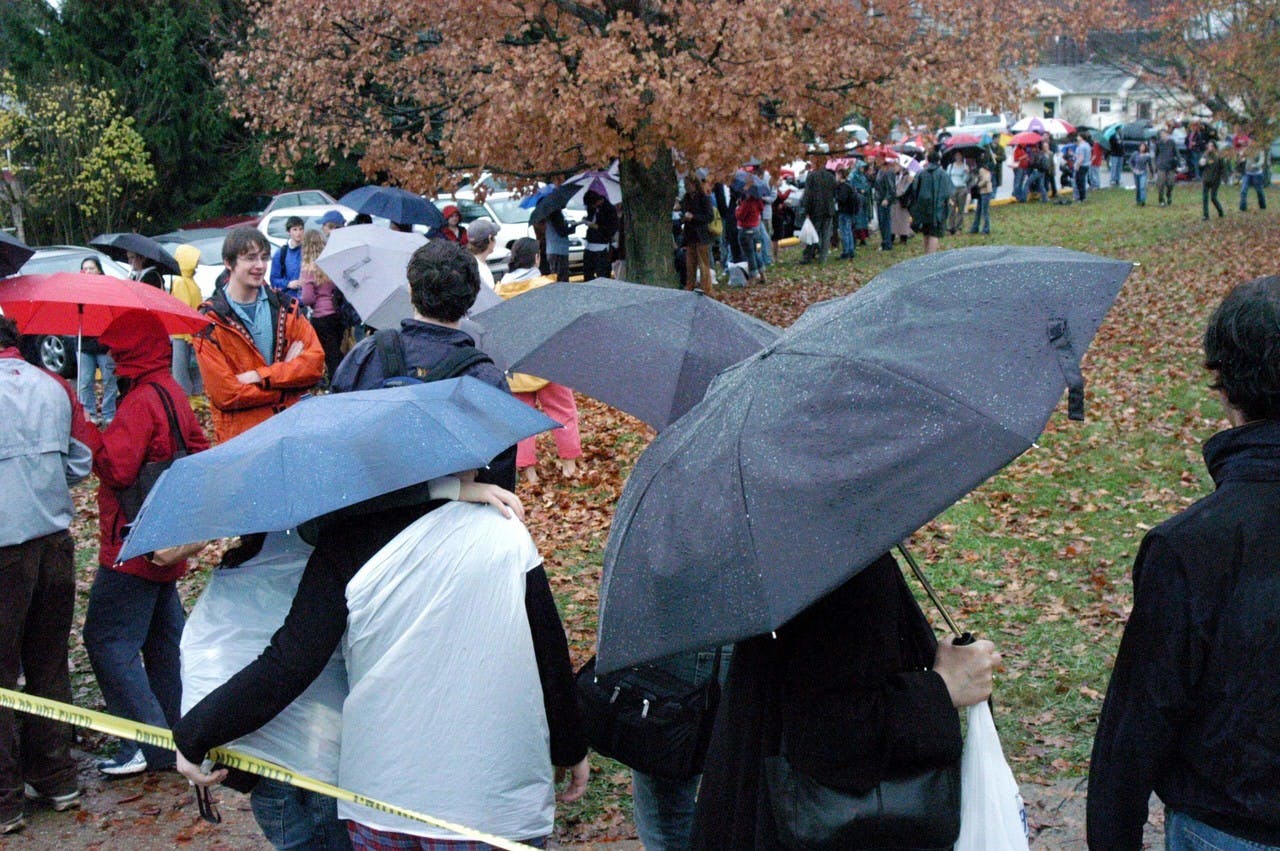
Gambier residents braved downpours and several-hour wait times to vote in 2004.
Inspired by the long lines in 2004, Robert A. Oden, Jr. Professor of Biology Joan Slonczewski became a poll worker in 2005. She feels that the lines were the result of unanticipated voter turnout and inadequate preparation.
“In 2004, the people who ran the poll were not accustomed to having [a] high turnout of students,” she said, “and they were slow to recognize the large number of people from Gambier registering to vote.”
Student participation in the 2004 election was unprecedentedly high and has generally increased in the elections since then, according to Slonczewski.
In 2004 there was debate among the student body and in the wider communities of Gambier and Mount Vernon as to whether or not students should be allowed to cast their vote in Ohio. Because Ohio is a swing state and thus vital to election results, certain Gambier and Mount Vernon residents felt that students — whose views are typically more liberal than the remainder of Knox County — should not vote outside of their hometowns.
“We certainly had a couple letters to the editor and guest columns going back and forth during that year about whether or not students really should vote in their hometown, or if people really should vote in their college [town],” Bryan Stokes II ’05, then editor-in-chief of the Collegian, said. “It was a heated argument.”
Former President Nugent’s voter registration experience indicates resistance went beyond the views expressed in the Collegian. She recalls making a trip to the Knox County Memorial Theatre Building, where she overheard Mount Vernon townspeople maintain that Kenyon students should not affect local voting.
“There was clearly resistance to having students vote,” she said.
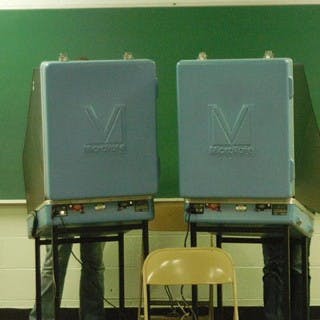
Gambier maintained two voting machines for 1,300 voters.
But Lanning, who was a clerk during the 2004 election, disagreed. In her view, the long lines were caused by poor planning on the Board’s part. She said the Board did not expect so many registered voters to actually vote and could not have anticipated one of the polling machines malfunctioning.
“There was absolutely no intention of not letting everybody vote,” Lanning said.
The Knox County Board of Elections followed procedure on that pivotal day in 2004, according to Lanning. She explained she always tells her poll workers there are two things you can do wrong on election day: one, not open at 6:30 a.m., and two, turn away a voter. Neither of these errors happened on November 2. “Everybody got to vote,” she said.
But in the case of the longest line, not everyone who intended to vote did so. Some community members did not want to wait in the line, or could not wait as long as was necessary. Although Kenyon students could be excused from class, other voters had jobs and families to tend to. Even students and faculty hoping to cast a ballot may have left to write or grade papers, Hyde said.
Slonczewski acknowledged that long lines are “a hardship for working people.” Stokes agreed, saying it would be impossible for certain employed community members and college maintenance staff to stay away from their jobs for as long as was necessary. “There was a danger of disenfranchising people based on their job circumstances and class,” he said.
In a June 1, 2006 Rolling Stone article titled “Was the 2004 Election Stolen?” Robert F. Kennedy Jr. explores inequitable access to voting in the 2004 election, particularly in minority communities and in Ohio. He also mentions the long lines at Kenyon as part and parcel of the voter suppression in Democratic precincts. He quotes retired pollster and journalist Lou Harris, whom he calls the father of current-day political polling, as saying, “Ohio was as dirty an election as America has ever seen.”
Van Holde doubts there was voter suppression at the local level. If it did occur, however, he blames the secretary of state’s office. “Ken Blackwell, who was the then secretary of state, was a very strongly right-wing Republican, and he was also the Ohio chairperson for the re-elect George Bush campaign,” he said. “And he used a whole long variety of different methods to try to — what’s the verb I want to use? — control the electoral process.”
Van Holde believes this is the larger problem in Ohio: Secretaries of state are in charge of running the elections, and if they are a member of a particular party then “they can and not infrequently have used that party affiliation as a way to sort of try to get things to tilt their direction.”
According to Stokes, many students voted for the first time in the 2004 election. He fears that first time voters who had a negative experience might be dissuaded from voting in the future. “I think it’s problematic for us to … have a society where voting has to [be] a symbol of sacrifice or serious kind of disruption to the day,” Stokes said. “I think there are much better models.”
Van Holde agreed. He feels it should be easy for people to vote, and said he recently signed an electronic petition to make election day a national holiday.
“If you don’t make it easy for people to vote, then while you may not be strictly preventing them from voting, you’re stacking the cards against them,” he said.
Later in the day
The Knox County Board of Elections brought in paper ballots after one of the machines began to have issues, inciting what Stokes recalled as increasing contention among voters waiting in line. What had previously been a positive atmosphere shifted, as a rumor circulated that the paper ballots might not be counted. Many people refused the new ballots, opting instead to wait for electronic ballots. “People started to feel as if their vote was being intentionally suppressed in some way,” Stokes said. “That there wasn’t a second machine brought in but in fact these paper ballots that may have been provisional.”
According to Hyde, Knox County had 114 machines and 56 voting precincts, and the rule of thumb was to put two machines in every precinct — meaning the Gambier Community Center was allotted two, and there were two spare machines left over. After one of the allotted machines in the Gambier Community Center began to have issues, one of the spares was used to replace the broken part.
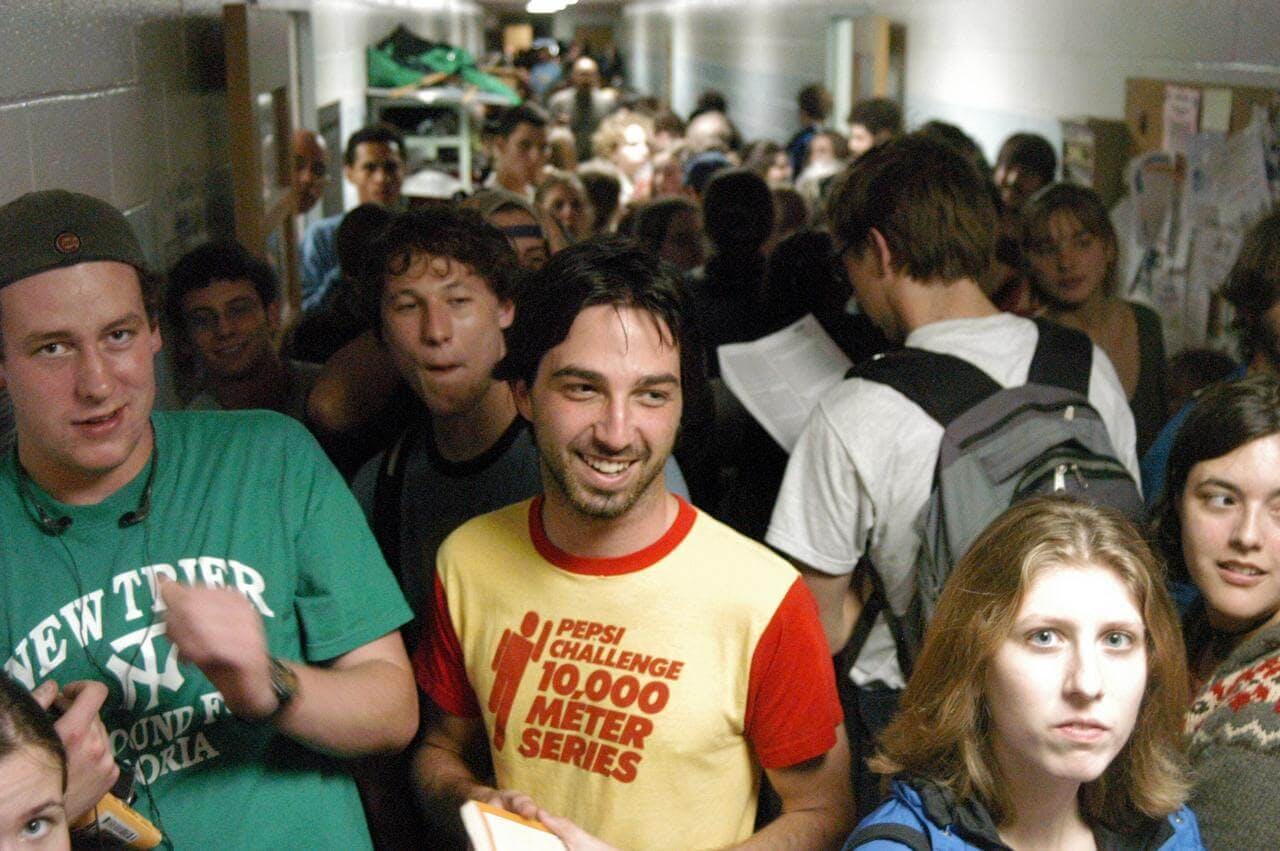
Crowds of students cram the Gambier Community Center to capacity while waiting for a chance to cast their ballots in the 2004 election.
It was impossible for another machine to be brought in, however. The machines in Knox County that election were no longer being manufactured. The Board also could not purchase a newer model of the machine, as there was a move in 2004 to replace the old machines, but Knox County had decided against doing so for reasons unknown.
The paper ballots introduced in the interim were valid, but rumors claiming the opposite circulated nonetheless. Hyde explained that because elections are now highly litigated, there was reason for voters to believe that their paper ballots would not be counted. Because a potential lawsuit after the election could render them invalid, “there was a reason to be cautious,” he said. Ultimately, only around 100 paper ballots were completed and the length of the line remained unabated.
A lack of resources
Slonczewski also explained that the Board faces a lack of resources when preparing for elections. “Knox County is a county of modest means, so [money] is a concern for Knox County,” she said. “It’s also a very rural, spread-out county, and so it is a challenge to come up with enough funds to provide what’s needed.”
Hyde concurred, explaining that underemployment and underfunding are perpetual problems for election boards around the country. “It costs money to run a democracy. This election was underfunded … and under-organized and there’s no place to point a finger,” he said.
Lanning explained that commissioners work well with the Board in terms of funds, though they usually need to ask for more money than allotted by their budget. Running a democracy is costly, and elections are an added expense. “It’s awfully hard to give an estimate until after the election’s done,” Lanning said. But as of Oct. 28 of this year, the Board spent $442,298, and that figure continues to rise.
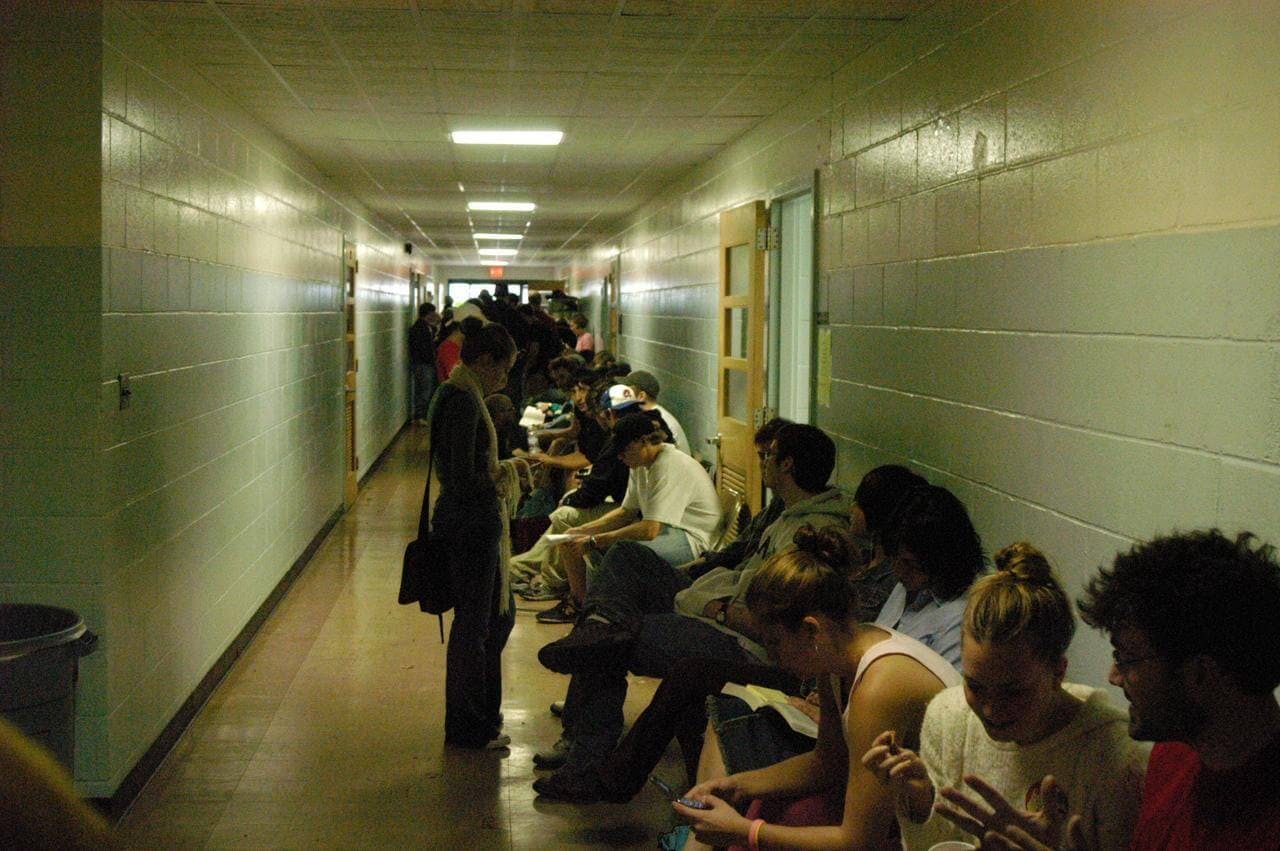
Gambier residents line the hallways of the Community Center, reading books and chatting to pass the time.
Limited funds are not the only challenge. The Board also suffers from a lack of bodies. Lanning is required to have at least four poll workers (two Democrats and two Republicans) at each polling location, but is “always understaffed.” The effects of understaffing are most acutely felt in the period leading to any election day, according to Hyde. He described elections in the U.S. as a “surge phenomenon,” with tranquility all year long and a spike in activity during election months.
Lanning cited more work and longer hours in the days and weeks before elections. “We have a lot of extra hours at election time, probably more than any other state,” she said. In the days leading up to the 2004 election, Lanning and others at the Board were registering voters until 10:30 or 11 p.m. every evening, and the phone would be ringing off the hook. When November 2 finally arrived, she and her coworkers went to work at 5 a.m. and did not leave until around 7:30 the next morning.
Aftermath of the election
Kenyon received international media attention as a result of its role in the 2004 election. “By the time I got up at 7 … the next morning, I had an email from a parent in Singapore who had already seen the story on CNN,” Nugent said. The press commended Kenyon students’ devotedness, and Nugent did not want to see the spirit of civic engagement — so keenly aroused by the election — fizzle out, prompting her to ask, “Is there a way to take this Andy Warhol, 15 minutes of fame … and turn it into something more enduring?”
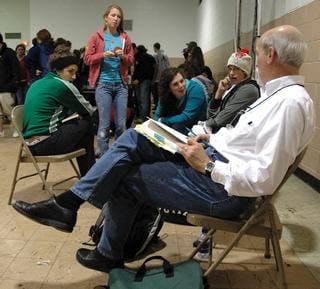
Students discuss the current state of the election with a professor while waiting for their turn to vote.
The answer: In 2007, the College founded the Center for the Study of American Democracy (CSAD). “I think [the Center] fits in fairly well with Kenyon’s self-identity or self-conception which is thinking big thoughts,” Director of CSAD Thomas Karako said. The Center brings speakers to campus, hosts conferences and debates and assists students in acquiring internships. And at its core, CSAD promotes constructive dialogue about today’s important issues. “It’s one thing to have The New York Times in the cafeteria and it’s one thing to stand in line at presidential elections 12 years ago, but there’s a host of other ways in which students ought to be more aware of the world around them, and also engaged in it,” Karako said.
Nor is CSAD exclusively the progeny of the 2004 election. It is also indebted to its predecessor — the Public Affairs Conference Center (PACC), a similar agent for the promotion of civic engagement and discourse at Kenyon during the 1980s.
In response to those who feel voting is a hardship, Karako offers a different perspective. “It’s not that hard to vote. It is a small sacrifice to do so,” he said. And with the genesis of early voting, it is only becoming easier, he says. According to Karako, Kenyon’s “longest line” was an opportunity to display its commitment to democratic principles. “On those rare occasions where you have the opportunity to do something more onerous for some common purpose, for a principle, and it is actually done — we look at that and we say that is good, that is noble,” Karako said.
Students in Hyde’s creative writing class felt a particular fondness for the 2004 election. Though the class initially wrote about nature around Gambier, Hyde and his students came to the mutual decision to shift gears. In lieu of nature prose, the class turned their focus to the recent election. Hyde described this as a “teaching moment,” in which engaging with the community’s pressing affairs was pedagogically relevant. “We didn’t try to take a position,” Hyde said. “We tried simply to tell the story as it was told by various players in the election.”
For Matt Segal ’08, these events shaped his future. In 2014, he founded a website with Jarrett Moreno inspired by the 2004 election. The site, called attn:, aims to deliver engaging news content to the digital generation and partners with the duo’s previous organization, the voter empowerment non-profit OurTime.org.
Lanning does not think the long lines in 2004 will ever happen again in Gambier, citing the replacement of the polling machines with the new paper ballot and scanner system this year. The paper ballots and scanners cut down on wait times, according to Lanning. Once voters check in at their polling place, they can take their time filling out the ballot. They do not need to wait in line until someone finishes, as was previously the case.
Contrary to 2004, the election this year ran smoothly, according to Slonczewski. Three Kenyon students volunteered as poll workers at the Gambier Community Center and Slonczewski said that there were “10 years’ worth” of paper ballots. But the efficiency Slonczewski accredits to the election was also perhaps a product of the shortest line. According to Slonczewski, few Kenyon students showed up at the polls on Election Day. She estimates that of the 500 voters who cast ballots at the Community Center, 250 were students. While she said lower turnout could be due to increased early voting, she remains disheartened by the numbers.
George Costanzo ’19 says he has never seen the campus in a comparable state of collective mourning following president-elect Donald Trump’s win. “I think we all kind of reacted as we would to any great tragedy,” he said. Costanzo decided it was imperative to create a forum for people to collectively grieve, while channeling the campus’s strife into action. He organized the student involvement drive “Let’s Do Something” so that students could sign up to volunteer for organizations promoting the social and environmental betterment of the community. “What I really wanted, and I think what everyone else involved in the solidarity movement wanted as well, was just to give people an avenue to say how they feel and understand that they’re not alone and that we, as a Kenyon community, are here to listen and help,” he said.
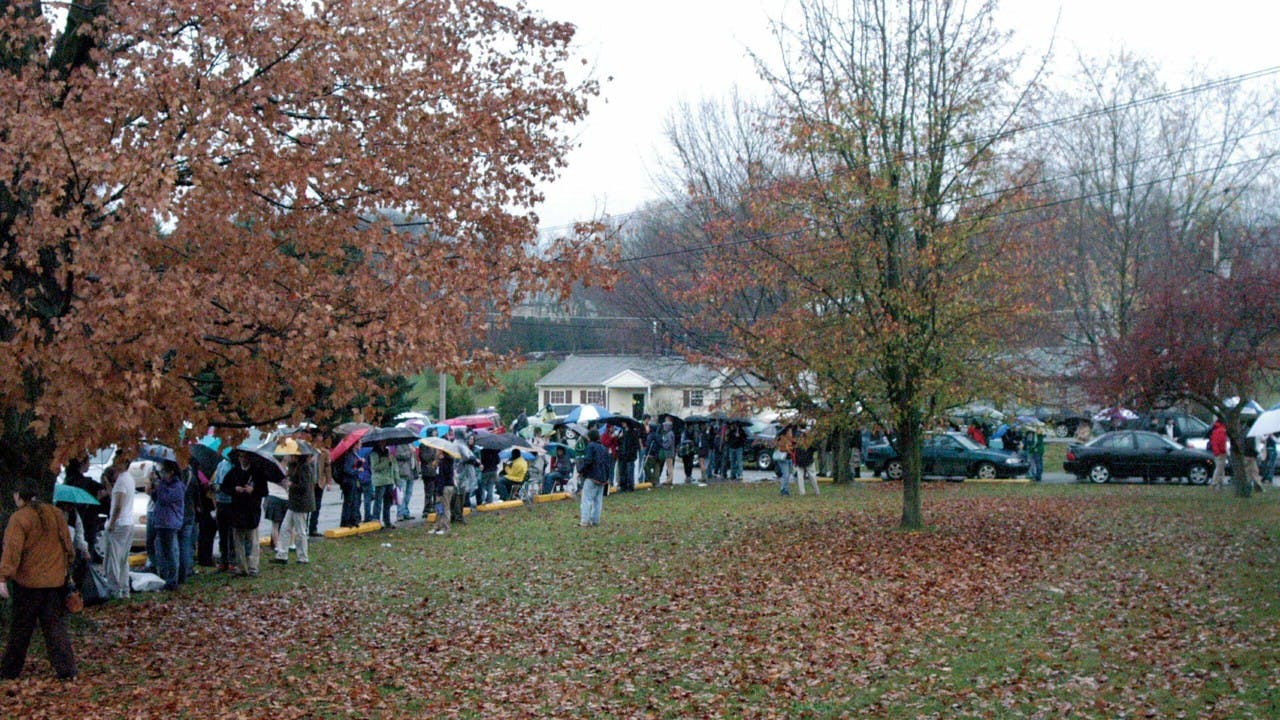
Students, residents and professors snaked around the Gambier Community Center for up to 11 hours on November 2. National outlets such as ABC News and Bloomberg picked up the story.
The “party atmosphere” Michaels encountered in the 2004 presidential election has, in 2016, partly given way to solemnness on campus. But as Costanzo’s reflections illustrate, both elections brought the Kenyon community together. To continue this sense of political activism on the Hill, Slonczewski urges voters be informed, to hold their state and local representatives accountable and to vote in every election.
Although the 2016 election has come to a close, the events of 2004 are not forgotten. Today, if you venture to the Greenslade Special Collections and Archives, you will find a thick folder of recollections about “the longest line.” Within lies a letter to the editor of the Collegian two days after November 2. Tom Susman ’04 wrote, “I have never been more proud of my alma mater than I was Election Night 2004 … Late in the evening, NBC News reported on ‘a little town in Ohio’ where students refused to be disenfranchised and waited 10 hours to cast their vote. People asked, ‘Kenyon College, where’s that?’ I responded with pride and said ‘Gambier.’”
